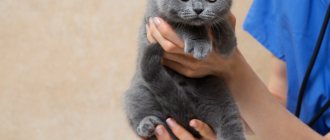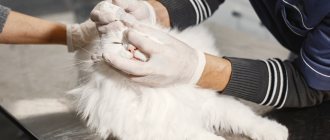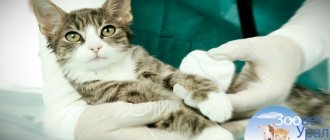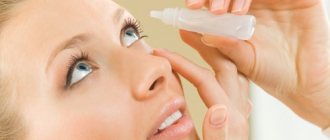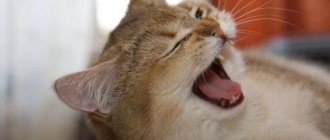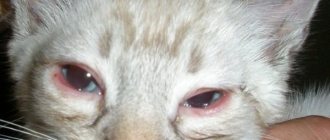In most cases, bleeding stops on its own.
What to do if it doesn't stop?
Firstly, as one famous fairy tale character said: “Calm, only calm!” When cats are excited, their blood pressure increases, which leads to increased bleeding. Try to calm your pet. Do not panic yourself, since the owner’s nervous excitement is transmitted to the animal.
Second, to constrict the blood vessels, place a cold compress (such as an ice pack) on the back of your cat's nose and hold it with gentle pressure so as not to impede breathing.
Once the bleeding has stopped, very carefully use a paper towel and water to clean your cat's nose as much as possible.
If the bleeding does not stop, or you notice other symptoms in your pet, such as breathing problems, contact your veterinarian immediately.
Why do cats have watery eyes, main diseases.
In what situations do British eyes need to be treated:
- Inflammation as a result of injury, dust or insects getting into the eye;
- Conjunctivitis has developed;
- Prolapse of the third eyelid;
- Epiphora.
It is important to correctly determine the cause of eye inflammation; you should look at the discharge:
- Discharge yellowish, brown, thick, pus – infectious, bacterial or fungal disease;
- Watery, transparent, pet rubs | scratches eyes with paws - allergies, injury;
- Crusts, transparent, dried - dust or dirt has gotten into your eyes.
Conjunctivitis.
Infectious diseases, helminthic infestation, allergic reactions are the main causes of inflammation of the conjunctival sac.
Contagious diseases.
Lacrimation is a symptom of the following diseases: toxoplasmosis, chlamydia, calcivirosis, rhinotracheitis, panleukopenia. Both British breed cats and animals of other breeds are susceptible to this disease.
If left untreated, conjunctivitis becomes purulent, which will lead to the development of uveitis and may result in blindness.
Elimination of inflammation - treatment of the underlying disease.
Worm infestation.
Nematodes that live in the intestines produce waste products that have allergenic properties. As a result, the cat develops lacrimation and other pathological symptoms.
Elimination of conjunctivitis - deworming the cat with an anthelmintic; it is better to use 3 in 1 products - against fleas, ticks, and worms.
Allergic reaction.
The British, like other artificially bred breeds, are susceptible to allergies. The British breed also has a special skull structure.
Irritants that cause lacrimation:
- Cigarette smoke, dust, perfume, eau de toilette, air fresheners;
- Feed | food allergens. Poor quality feed causes hypersensitivity. Natural feeding often causes skin rashes and it is difficult to determine the source of the allergen.
Read more about foodborne dermatoses here.
Treatment - eliminate the inhaled irritant, find out the cause of the allergic response, use antimicrobial eye drops:
- “Diamond Eyes” - contains chlorhexidine;
- “Iris” contains gentamicin.
Prolapse of the third eyelid.
Blinking membrane disease | third century. Forms in which inflammation can occur: abnormal development of supporting cartilage, protrusion | prolapse, adenoma. If both eyes are affected, it is a contagious disease.
Antiphlogistic drops and ointments are used for unilateral inflammation. The effect is not achieved - they operate surgically.
Epiphora.
Epiphora is characterized by copious continuous discharge and very watery eyes. Britons experience blocked tear ducts or inflamed eyelids | blepharitis due to the special structure of the lacrimal canal.
Treatment - wash the eyes and place tetracycline ointment in the conjunctival sac for 5-7 days. The treatment did not help - they operated on him.
This is interesting: The cost of a British kitten
How to independently determine the cause of the disease?
Of course, to get a qualified answer to the question of why a kitten is sneezing, you need to consult a veterinarian. However, when it is not possible to visit a veterinary clinic, you can use self-diagnosis methods. First, you just need to watch your pet. If he sneezes and rubs his nose, then it is quite possible that there is a foreign object in the nasal cavity.
To more accurately determine the cause of the disease, you need to pay attention to the nature of the mucus; clear discharge indicates an allergy, and green or gray discharge indicates an infectious or fungal disease.
Constant sneezing, which produces snot and swollen eyes, is a sign of an allergic reaction. If an unpleasant odor from the oral cavity is added, then injury to the gums or teeth is possible.
Cats, like all living things, may sneeze from time to time, and this is normal. Thanks to this, dust, dirt, and trapped hair are removed. This is a protective reaction of the body. When sneezing occurs constantly, you need to contact a veterinarian to solve the problem.
Prevention measures
Cats are incredibly clean and can take care of their eyes on their own. They wash themselves regularly, putting themselves in order, but they are not able to cope with the disease. Owners of four-legged furry dogs should check them regularly. Particular attention is paid to animals that walk outside. To prevent pathology it is necessary:
- Feed your pet high-quality food. Balance your diet and don’t experiment with it.
- Visit the veterinarian, get vaccinations and examination of internal organs.
- Ensure your pet has an active lifestyle, play with him, and go out into the fresh air.
- Protect from contact with sick and unfamiliar animals.
- Regularly cleanse the body of helminths.
- Monitor the length of the claws and trim them in time so that the pet does not injure itself.
Owners of purebred cats prone to excessive tearing should make it a rule to treat their eyes daily. With increased tear production associated with the characteristics of the breed, you may not immediately notice that the animal has health problems. Monitor the nature of the discharge and pay attention to your pet’s behavior.
Simple prevention methods will help protect your cat from various troubles, including eye problems. If you have the slightest doubt about the causes of tearing, contact your veterinary clinic. Remember that home remedies are temporary measures to combat the problem. Only a doctor can rid an animal of the causes of unpleasant discharge.
This article will tell you what to do when a Scottish kitten has watery eyes. In addition, we will identify the reasons why the eyes become watery and tell you how to distinguish whether a kitten’s eyes are watery or festering.
Heartworm infection in a cat
It is extremely rare, but still occurs in practice, that such cute creatures as cats become infected with heartworms when they find themselves in places with very high air humidity and a maximum number of mosquitoes. Why these insects? Yes, because it is through their bite that the parasite is transmitted to the pet. The heartworms themselves, once in the cat’s body, affect the right side of the heart, as well as the lungs. As a result, the arteries become clogged, it becomes difficult to breathe, and coughing and sneezing begins. And the end is often sad - a heart attack and death.
To protect your mustachioed pet from these parasites, follow the following preventive measures:
- maintain strong immunity,
- ensure proper diet and lifestyle.
And when traveling outdoors, you can prepare a special mosquito repellent in advance (dilute citronella with plain water). This composition will reduce the risk of parasite infection to a minimum, which will undoubtedly preserve the health and, of course, the life of your pet. This is just the simplest measure to prevent infection with malicious worms. Your veterinarian will cover this topic in more detail.
Additional symptoms
If the problem is not related to allergies, then the pet may have noticeable redness of the conjunctiva.
When a British cat's eyes become watery due to the influence of an allergen or irritant, no additional symptoms may be recorded. In this case, no special treatment is required and the problem goes away on its own after the irritant is eliminated. When pathological factors become the source of increased tearing, the Briton may develop a fever and experience other clinical signs:
- swelling in the area of the visual organs;
- purulent or mucous discharge;
- brown or red crust in the corner of the eye;
- itchy sensations;
- swelling of the conjunctival membrane and its redness;
- fear of bright light.
With prolonged tearing, Britons often experience hair loss around the eyes, which soon leads to sores and dermatitis.
My cat sneezes and snorts. What's the matter? General information
Sneezing and snorting seem like obvious enough signs to identify, but it's not always easy to tell them apart in pets. Indeed, these two symptoms can sometimes appear so that many people use the terms interchangeably. Sneezing is usually defined as a sudden, involuntary movement of air from the lungs through the nose and mouth. This phenomenon usually occurs in response to some irritant of the upper respiratory tract, most often to the thin receptor structures of the mucous membrane that lines the nasal passages.
A snort, on the other hand, looks and is identically defined as a sneeze. The difference is that sneezing is involuntary, while snorting is a voluntary effort on the part of the pet.
Dogs and cats sneeze and snort for a variety of reasons related to the functioning of the upper respiratory tract. While many are normal and benign reactions to simple irritation, some may signal infections, upper airway obstructions, and allergic diseases. There are also other pathological conditions of the upper respiratory tract.
Grown-up individuals
After 6 months of age, any discharge from the animal’s eyes should stop. If the problem does not disappear, it is worth monitoring the pet’s behavior. If a Briton’s eyes are watery for several days, the cat scratches them and squints, we can assume different versions:
- hit by a speck;
- blockage of the tear ducts (the eyes begin to sour);
- mucosal injury;
- allergies to various pathogens;
- helminthic infestations;
- infections – dangerous and not so dangerous.
Before proceeding with treatment of the pathology, the cause of lacrimation should be established.
Preventive measures
In order for an animal not to get sick, it must eat properly. Cat nutrition is the key to their health and longevity. You should not feed your pets from your own table. You should initially accustom your four-legged friend to a certain diet. It should be remembered that food should be without salt and spices.
It is very important to keep the room clean and tidy. Sometimes tearfulness in animals appears as a reaction to dust. To prevent this from happening in the future, you need to do wet cleaning once a week.
The British cannot tolerate drafts or smoke, so it is better not to smoke in a room where there is an animal. Clear eyes indicate the health of the animal, while their cloudiness, as well as tears, indicate some kind of problem. When using eye drops, they should be applied in small quantities to check for an allergic reaction. Only after this can therapy begin.
Did you like the article?
Symptoms
If a pathological cause is obvious, all manifestations of the disease should be observed to give the doctor as complete a history as possible to ensure the best decision.
Common cat diseases manifest themselves as follows:
| Symptom | Disease and cause |
| Long and profuse tearing. | Viruses and fungi such as plasmosis: calcivirosis, mycoplasmosis, toxoplasmosis, etc. |
| Pus. | Foreign objects. |
| Edema. | Turn of the century. |
| Cloudiness. | Keratitis, cataract. |
| Black spot. | Dying of the cornea. |
| Tears are accompanied by fever, diarrhea, vomiting, and lethargy. | Feline distemper (panleukopenia). |
| Swelling with cloudiness. | Glaucoma. |
| Swelling in the corners of the eye. | Inflammation of the lacrimal glands. |
| Redness of the membranes, photophobia. | Conjunctivitis. |
| Damage to one eye. | Parasites. |
This is interesting: When to castrate a British cat
What to do and how to deal with the problem?
“Diamond Eyes” drops will put the animal’s visual apparatus in order.
If your Briton's eyes start to water, you can help your pet at home. Antiparasitic drugs are purchased from a veterinary pharmacy and given to the animal. In this case, it is recommended to prepare a chamomile-based decoction or strongly brew black tea and wipe the Briton’s sore eyes several times a day so that they stop watering. The procedure is performed with clean hands, using a separate cotton pad for each visual organ. If home methods do not help eliminate excessive tearing in cats of the British breed, then contact a veterinarian who will conduct an examination and prescribe drug therapy. The following veterinary drugs help with violations:
- "Iris";
- "Diamond Eyes";
- herbal lotion “Fitoelite”.
You should not give pets medications at your own discretion, since many of them have contraindications and can lead to complications. To combat increased tearfulness, tetracycline ointment is used, which is placed under the eyelid. Furacilin solution and potassium permanganate diluted in water are also useful. British people wash their eyes with these products several times a day. To prevent watery eyes in British cats, you should monitor their diet and avoid allergic reactions and parasites.
How are nosebleeds treated?
Of course, veterinarians treat the disease that caused this unpleasant symptom. Animals with infections are given antibiotics and other drugs, with hypertension, blood pressure is reduced, and in case of poisoning, toxins are removed.
If tumors are found during the study, doctors take pieces of them for analysis - they do a biopsy. Only after this can the possibility of performing operations to remove these tumors be assessed. Complex injuries and deep penetration of foreign bodies are treated surgically.
In addition to eliminating the cause, symptomatic treatment is also prescribed to reduce the likelihood of bleeding. To do this, the animal is given injections of substances that promote blood clotting (drugs such as Ditsinon and Vikasol are most often used).
We have taken a detailed look at the information that an owner needs to know about nasal bleeding in cats. We hope that knowledge and confidence in your actions will help you provide first aid to your cat if necessary.
Eye diseases typical for the breed
It is not uncommon for a British cat to have watery eyes due to a common cold caused by sitting in a draft. The presented breed has a “weak spot” and these are the eyes, so sometimes the problem can make itself felt even when, it would seem, there are no provoking factors.
Conjunctivitis
If a Brit's eyes are watery, conjunctivitis may be suspected. The trouble occurs due to inflammation of the eye membrane, which is caused by various pathogens. For the disease to make itself known, it is enough for the animal to rub its muzzle on dirty shoes, for example.
Worm infestation
Experienced breeders know that the parasites that live in the intestines of pets, or rather the waste products of worms (nematodes), lead to the development of allergies, which are manifested by tearing, sneezing, and sometimes hair loss. Therefore, if cats have not been given anthelmintics for a long time, then it will not be a bad idea to do so. The tearing of the eyes of a British kitten caused by this problem will stop the very next day.
Contagious diseases
Sometimes the eyes become watery because the animal is seriously ill.
This could be one of the following diseases:
- rhinotracheitis;
- toxoplasmosis;
- panekleukopenia;
- toxoplasmosis;
- calcivirosis.
Often, a serious illness is manifested not only by the appearance of tears, but also by other striking symptoms that cannot be ignored. In this case, it is necessary to begin to eliminate the underlying disease.
Important! If treatment within 1-2 days does not have an effect, you should immediately seek help from a veterinarian!
Epiphora
It's one thing when British kittens have watery eyes, but it's quite another when the animal literally washes itself with tears. In this case, we can assume that the pet was struck by epiphora. This disease is not uncommon in the British population, due to the structure of their tear ducts. During inflammation of the eyelids or blockage of the canal, spontaneous release of fluid occurs.
Third eyelid prolapse
One common eye condition in the UK is nictitating membrane or third eyelid. In this case, inflammation develops, occurring in several stages.
Namely:
- adenoma;
- dropping out;
- abnormalities in the development of supporting cartilage.
In this case, the British eyes water, but only at the initial stage. Then pus may begin to ooze. If you do not begin to eliminate the disease in time, it may lead to surgical intervention .
Other Possible Problems
If more than two weeks have passed since birth, and one of the kitten’s eyes does not open, this should alert the owner. This phenomenon may be the cause of the development of a pathological deviation. It is best to show the animal to a doctor.
Important! If the cat's eyes do not open and are watering, this may indicate a foreign body. The appearance of pus indicates the development of conjunctivitis
Young kittens are very vulnerable to viral infections. Harmful bacteria can come from both the external environment and the womb. Therefore, owners of newborn kittens often experience inflammation of the organs of vision.
Eye is leaking
The reasons why a kitten's one eye is watery can be due to many factors:
- the appearance of infection is the most common phenomenon. The most common are chlamydia, herpes and mycoplasmosis, which are also contagious to humans. The presence of infection can only be determined through analysis of eye wash;
- allergic reactions may occur to food, dust and household chemicals;
- mechanical eye injuries that appear either after active play of kittens or due to burns. A speck of dirt can also get into the kitten’s eye, which will cause injury to the cornea, the eye will begin to hurt and leak;
- infection of an animal with parasites;
- disruption of the gastrointestinal tract;
- prolonged exposure to lighting devices, a bright light source.
Only a doctor can name the exact reason why a kitten’s eyes are watering. The conclusion is made after the diagnosis. As soon as an accurate diagnosis is made, the doctor prescribes how to treat the cat.
Tearing will be considered normal when it comes to Scottish and British breeds. It all depends on the structure of the skull. Due to the fact that these breeds have a flattened muzzle, their eyes are susceptible to the influence of the environment, and they constantly leak. Owners of these breeds should contact a veterinarian if they see changes in their pet's behavior.
Important! You need to monitor the color of the discharge from the eyes. If tearfulness with pus is observed, you should immediately contact a veterinarian
Pus from the eyes indicates the beginning of the inflammatory process.
A kitten's eye is leaking
If clear discharge without blood or pus is detected, you can get rid of it at home. To do this, you can wash your pet's eyes with tea and chamomile infusion. Products sold in pet stores have a good effect. You can purchase eye drops that will produce results within 2 weeks. If after treatment the cat continues to squint his eyes, they close and run, you need to show him to the veterinarian.
Squints his eyes
Pet owners should be wary if their pet squints one eye. This indicates that he is experiencing pain and discomfort. Most often this is accompanied by severe lacrimation and suppuration. In this situation, you urgently need to show the animal to a doctor and take the necessary measures for treatment. Squinting of the eyes can occur for a number of reasons:
the development of conjunctivitis is an inflammation of the mucous membrane, which is accompanied by swelling and purulent discharge. The diseased organ of vision becomes swollen, it begins to close and turn red. For treatment, special drops and rinsing are used. If the disease is detected late, antibiotic injections are prescribed; mechanical injury to the cornea, accompanied by severe pain. The complexity of such phenomena lies in the fact that microorganisms can enter small cracks in the corneal tissue and subsequently multiply.
Particular attention is paid to injuries caused by claws, under which a large number of bacteria accumulate, as well as worm eggs; Allergic reactions can be to household chemicals, dust, or to flowers and plants. If a kitten begins to squint its eyes in order to identify the causative agent of the allergy and prescribe treatment, the doctor conducts a diagnosis by taking tests; increased eye pressure
Most often, this phenomenon occurs in old animals due to age-related changes. If treatment is not taken, this condition can lead to blindness; Corneal erosion or damage to the membrane are the most common reasons why a cat squints. The impetus for infection comes from injuries, burns, and viral infections. If left untreated, the disease will lead to serious consequences such as corneal erosion.
Conjunctivitis
If your pet begins to constantly squint his eyes, you need to urgently take him for examination.
Are watery eyes a breed trait?
You can often hear the following phrase from veterinarians and pseudo-experts regarding lacrimation in the British: “What do you want? This is such a breed, their eyes are always streaming.” There is some truth in this, but only partly. Let's figure out why British cats actually have watery eyes.
Representatives of the British breed are brachycephalic, i.e. cats with a spherical head shape, including due to the fact that they have a shortened muzzle. Compare the skull of a brachycephalic and a non-brachycephalic.
The spherical head is a breed standard, giving it a special charm, but with it the British received an atypical anatomical structure of the nasolacrimal ducts. Brachycephalic cats and dogs have some curvature and deformation of the nasolacrimal ducts, which, when severe, makes it difficult for tears to flow into the nasopharynx.
Despite this, normally a British cat should not have constant lacrimation. Most representatives of the breed have healthy eyes, because breeding cats and female cats are selected not only for beauty, but also for health. We are, of course, talking about animals from officially operating nurseries according to all the rules. You can expect anything from the British, bought second-hand.
If there is a problem with lacrimation, this means that:
- the breeder did a poor job and was unable to maintain in his graduates the structure of the nasolacrimal duct that allows normal functioning;
- or the cause of lacrimation is not anatomical features at all.
Also, it often seems to the owner that the condition of the eyes is unhealthy, but, in fact, everything is in order. Below we will teach you how to distinguish normal from pathology.
Manifestations of pathology
Before treatment, the animal’s condition should be assessed, so pay attention to the duration and nature of eye discharge, the presence or absence of other symptoms. Signs may be as follows:
Signs may be as follows:
- profuse lacrimation;
- swelling around the eyes;
- brown, green and yellow discharge;
- impurities of pus in the discharge.
A Scot with pathology may constantly rub his eyes.
In some cases, symptoms include:
- hyperthermia;
- copious nasal discharge;
- drowsiness;
- changes in habitual behavior;
- apathy;
- pet anxiety;
- cough.
If symptoms appear that are not normal, you should consult your veterinarian.
Normal and pathological - how to distinguish?
Many owners notice brown crusts in the corners of their cats' eyes after sleeping. This is the norm. When released, the tear is transparent and does not have any impurities. The liquid then lingers on the fur and oxidizes in the air, resulting in the feeling that your British cat's eyes are watering brown. In fact, brown crusts (sometimes they have a reddish tint) are just dried, oxidized tears. It looks like this.
Pathology is observed when:
- tears flow constantly, even while awake, there are a lot of tears, as if a cat is crying (scientifically the phenomenon is called epiphora);
- the tear is cloudy, whitish, greenish or yellowish;
- in addition to the tears, it is clear that the eyelids and conjunctiva are inflamed;
- hair falls out around the eye;
- blepharospasm (the cat squints its eye).
British eye care
The eyes of a healthy Briton do not require special care. If brown crusts form after sleep, they should be removed using a cotton pad moistened with water or a special cleaning solution. Otherwise, tear tracks may stain the fur.
If the cause of lacrimation is hair constantly getting into the eyes from the face and body, the cat needs to be thoroughly combed, during periods of shedding - every day. It is impossible to comb out small hairs on the face, and therefore they can be plucked with your fingers. Dead hairs are easily plucked out, but there is no need to pull out still living hairs - let them grow.
And one more important point: if a Briton’s eyes are constantly leaking, the owners resort to rinsing. This helps when the cause of lacrimation is hair getting into the eyes, as well as when a bacterial process begins. But you cannot use rinsing with water or herbal decoctions constantly. Even harmless chamomile or tea are liquids hostile to the microflora of the eyes. Without consequences and for a long time, you can only use a saline solution that is close in composition to the natural environment of the body.
Rules for washing and instilling eye drops
If one of the points of treatment for a cat is eye drops, then it is important to know how to carry it out while causing minimal discomfort to the pet.
For this you need:
- sterile pipette or syringe;
- product (drops, ointment) at room temperature;
- clean wipes or tampons;
- food to encourage and relieve stress in cats.
It is advisable to carry out the burial with an assistant who will help hold the frightened animal. The cat must be well secured. In extreme cases, it is tied with soft cloth.
With a moistened swab, wipe the pet's eye from the outer corner to the inner, removing crusts and drops of secreted liquid. Then the eye is wiped again with a clean napkin.
Now you can start instilling: open the cat’s eyes wide with the thumb and forefinger, after which the product is quickly instilled directly under the eyelid. Excess liquid is blotted with a napkin, then the cat is rewarded for its bravery and released.
Pregnant and small pets require a special approach. Cats expecting the birth of babies are rarely prescribed medications; rinsing is done with chamomile or calendula decoctions, a tea solution, and in extreme cases, tetracycline ointment is applied. Newborn kittens with high tear production are prescribed Bars or Anandin drops.
Pathology or not
If a cat’s eyes are running, this phenomenon may be normal or indicate a pathological process.
In case of various diseases in a pet, the discharge is characterized by an unusual color (yellow, transparent, red, brown, green). In pathology, tears flow heavily, the eyes are slightly swollen, and the animal constantly rubs them. Sometimes the cat cannot open them completely.
Discharge rate
In cats of this breed, discharge is considered normal if:
- they are transparent;
- not very abundant;
- occur after sleep.
In this case, there is no need to treat the animal. This is a normal process in British breed cats.
Treatment of eyes at home, what to wipe with, what to do?
Your pet can treat the affected areas at home, either with special veterinary products or with medications from a pharmacy.
Step-by-step processing instructions | rubbing the eyes of a kitten, cat:
- Wash your hands well with soap and call an assistant;
- Prepare a 5 ml syringe with a rubber piston, cotton pads;
- Prepare distilled water | boiled, necessary drops or ointments;
- Particularly violent ones should be wrapped in a blanket or towel and placed with their backs on their knees;
- Soak the disk with water and solution. Wet your eyelids if they are stuck together;
- Gently move the wet disc from the outer edge to the inner corner along the surface of the eyelids; if the eyelashes are stuck together, move from the inner to the outer;
- Dry crusts are removed and the cotton pad is changed more often;
- After rinsing, drop the solution onto the cornea or apply ointment, massage the eyelid a little and blot off the excess with a cotton pad.
Any solution is at room temperature. Use clean cotton pads for each eye. Do not touch the cornea, blot the eyeball.
Eye washes
Pharmacy products.
The following medications can be purchased at the pharmacy:
- Decoction of herbs, tea: chamomile, hyssop, calendula, St. John's wort. 1 – 2 teaspoons of herb are poured with 0.5 glass of boiled water, left for 10 – 15 minutes, filtered, cooled, and wiped the animal’s eyes. In light-colored cats, the fur around the eyes may become stained. Only freshly prepared infusions are used;
- Chlorhexidine solution 0.01%;
- Saline solution 0.9% - sodium chloride solution 0.9%. A higher percentage will lead to burns of the mucous membrane;
- Furacilin solution 0.02%;
- Antibiotic drops chloramphenicol, ciprofloxacin, tobrex - for purulent conjunctivitis, prescribed by a doctor.
Veterinary products.
Veterinary pharmacies, clinics, and pet stores offer the following products:
- Tetracycline eye ointment 1% - antibiotic;
- Oftavetin cipro is an anti-inflammatory, antibacterial drug;
- Oftavetin dexa - antiallergic, anti-inflammatory effect;
- Optimmune - ointment, active ingredient - cyclosporine A;
- Anandin – treatment of infectious diseases, rhinitis;
- Maxidin is a drug for the treatment of allergic and infectious diseases of the eyes and upper respiratory tract;
- Iris – treatment of eye diseases;
- Diamond eyes - drops for daily hygienic treatment;
- Oftalmosan - the drug has anti-inflammatory, antiseptic, detergent properties, relieves swelling of the eyelids, reduces itching;
- Tsiprovet - prescribed for blepharitis, keratitis, corneal ulcers, septic iridocyclitis, conjunctivitis, keratoconjunctivitis;
- Bars - drops belong to combined antibacterial drugs with a wide spectrum of action;
- Doctor VIC lotion is a zoohygienic product designed to cleanse the areas around the eyes;
- Rosinka lotion is a hygiene product;
- Teardrop – hygienic lotion with royal jelly.
Every cat or dog owner may encounter eye problems with their pet. To minimize the problem, you need to feed your pet properly and provide the necessary timely care. Knowing how to treat a cat's eyes is as important a skill as being able to trim its claws. Save the article to bookmarks and share with friends.
Treatment options
Before starting treatment for tearfulness, you should carefully study the nature of the discharge and the condition of the animal. Contacting a veterinarian is mandatory and immediate if not only the eyes are running, but also the following symptoms and conditions are observed:
- increased body temperature;
- refusal to eat and drink;
- the appearance of pus in the nasolacrimal duct.
When your pet's health condition does not cause concern, you can resort to simple but effective treatment methods at home. Among them:
- Regularly rubbing your eyes. Herbal decoctions and tea leaves are suitable for this purpose. You can purchase a special herbal-based lotion Phytoelite. To eliminate possible infection and disinfect mucous membranes, dissolve potassium permanganate in water until a pale pink tint appears and wipe the eyelids, moving towards the bridge of the nose.
- Applications of tetracycline ointment are recommended to treat purulent eyes in the UK. The drug has a wide spectrum of action and inhibits the activity of microbes. To achieve a lasting therapeutic effect, the ointment is applied to the eyelids in a thin layer in the evening and left until the morning.
- A remedy called Iris will help eliminate irritation and allergic reactions. The composition contains chloramphenicol, which can quickly restore eye health.
- Diamond Eyes drops containing succinic acid and taurine have a good therapeutic effect. Suitable for combating the disease and preventing it.
It is recommended to treat watery eyes in British cats with medications only after consultation with a specialist.
An incorrectly selected remedy can aggravate the condition and lead to the development of chronic inflammatory processes. You can do the washing yourself, if necessary.
We are ready to help
Our clinic specialists treat nosebleeds and other diseases in your pets. If your cat is unwell, please contact us. We apply the latest technologies, use high-quality equipment, and guarantee high professionalism and attentive attitude towards four-legged patients. You can call our specialist at home or come to the clinic.
The article provides an opportunity to understand why such a problem may occur and answers questions about how best to deal with it and what to look for in solving the most common difficulties with bleeding in kittens
The kitten has a nosebleed and is sneezing: causes and treatment
If your kitten is bleeding when he sneezes, you might want to consider whether he may have inhaled some chemical that could be causing the symptoms. The kitten must be taken to a doctor immediately, but if this is not possible, then you should try to stop the bleeding and sneezing at home.
This can be done in the following ways: apply ice compresses to the kitten or give the pet a vasoconstrictor.
The kitten has bleeding from the nose and mouth, eyes, what should I do?
The kitten may bleed from the eyes, nose and mouth, perhaps in cases where it has fallen from some height, or it has eaten some kind of poison. In any case, a doctor’s examination is necessary, and the sooner the better, since nothing can be done to help the kitten at home.
How to stop a cat's nose bleeding
If a cat has bleeding from its nose, then, firstly, there is no need to panic, since nervous excitement is transmitted to cats, which in their case is extremely harmful, as it leads to an increase in blood pressure.
Secondly, you need to apply a cold compress to the back of your cat's nose, making sure that your pet does not block his breathing.
If the bleeding has not stopped and the cat has breathing problems, the animal urgently needs to be shown to a veterinarian. If everything is fine with breathing and the blood has stopped, there is no need to panic.
When the blood stops flowing, you should take a napkin and water and clean the animal’s nose.
Any bleeding in a pet causes strong emotions in owners: from anxiety to panic. Nothing human is alien to cats, and therefore they are susceptible to nosebleeds no less than people. Sometimes this is a single manifestation of some temporary disorder, sometimes it is a signal of a serious illness.
Let's figure out why a cat's nose bleeds when sneezing, and how you can help it.
Prevention of lacrimation
Whatever condition your British cat’s eyes are in now, you need to remember preventive measures.
- Take care of the animal's immunity, because... Often the cause of problems is latent infections and the riot of opportunistic microflora. Maintaining immunity consists primarily of healthy eating, physical activity and a lack of stress.
- Avoid contact between the animal and sick brothers. Many people like to pick up stray cats on the street and immediately bring them home. It is not right. The animal must be examined by a veterinarian followed by quarantine.
- Brush your cat regularly to keep dead hair out of your eyes. If you have already gotten it, you need to rinse your eyes.
- Do not use antibacterial eye drops unnecessarily. The organ can be constantly washed only with saline solution.
- Regularly give your cat raw meat, eating which provokes the secretion of tear fluid and clearing of the nasolacrimal ducts.
- Perform regular routine deworming and, if necessary, preventative or therapeutic treatment against fleas and ticks.
- Try not to use aroma lamps and sticks, aerosol air fresheners at home, and do not smoke.
- If a problem occurs, contact your veterinarian immediately. Do not engage in self-treatment, which blurs the symptoms and leads to relapses, and also makes it difficult for the veterinarian to make a diagnosis.
MORE ON THE TOPIC
